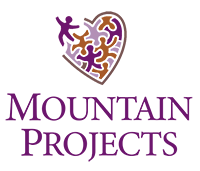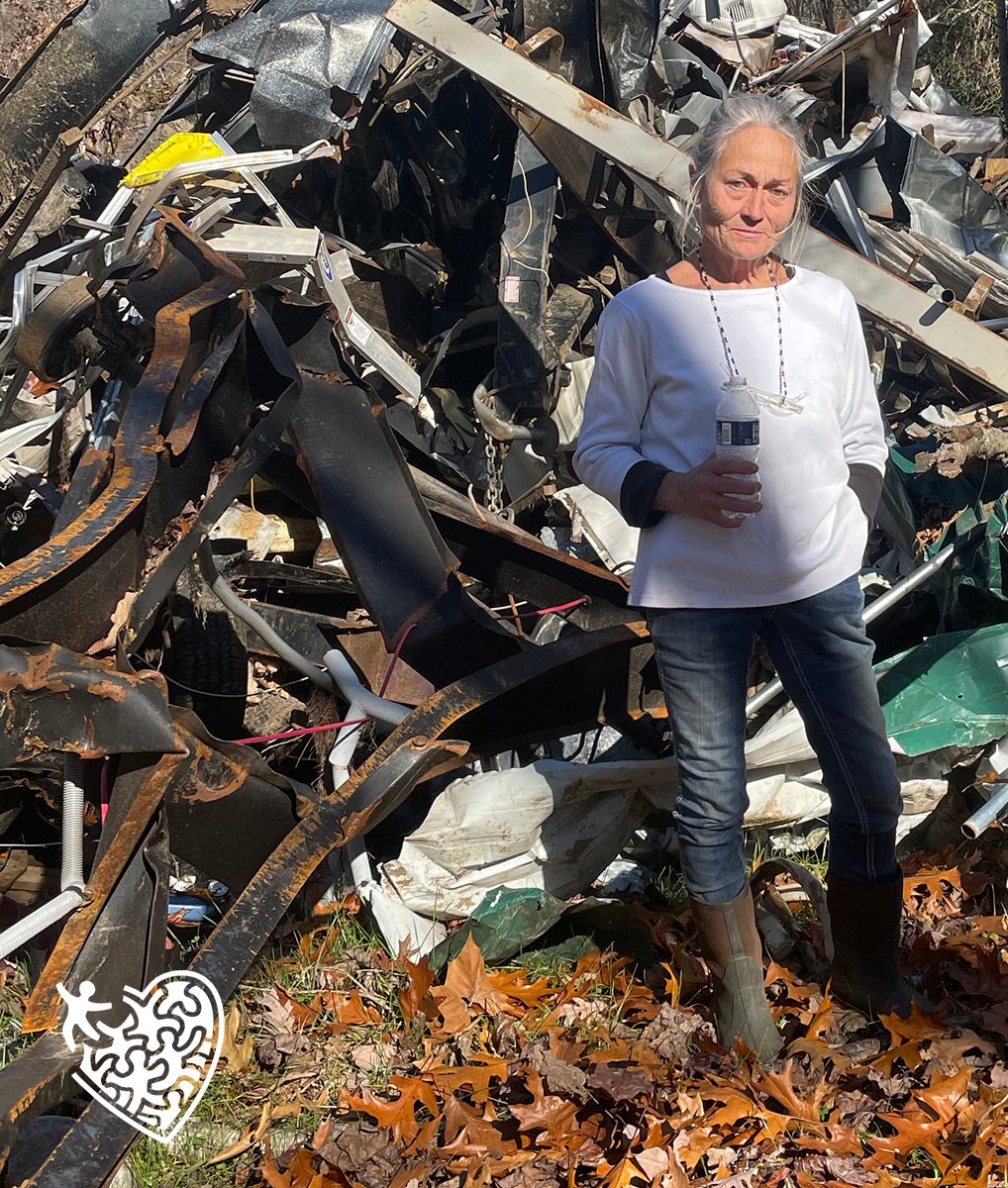A tiny lady with sturdy boots and a neat grey bun walks between high heaps of gnarled and tangled debris. Identifiable items poke out at odd angles: an axle with wheels here, an auger bit there. A hula hoop. Now and then the breeze carries a whiff of rot.
The Pigeon River slips by, just a stone’s toss away.
There’s a sense of sadness and confidence about her – a good-natured person who’s having a rough time. Bending down, she captures a windblown leaf, studies it, and remembers a nursery rhyme.
“A wise old owl lived in an oak,” she recites, pointing with her leaf. “The more he saw, the less he spoke. The less he spoke, the more he heard. Now, wasn’t he a wise old bird?”
Sherrie McArthur hasn’t heard too much lately, but she’s waiting.
Her 51-year-old family business in Cruso, Laurel Bank Campground, was utterly destroyed in August during floods wrought by the remnants of Tropical Storm Fred. Some guests died, others were traumatized, and her campground is unrecognizable.
Like many hardy residents of the valley, she’s buckled down and done her best. She hasn’t asked for much, and she’s accepted with grace the help that came her way. But now she’s grappling with the fact that she just doesn’t know what’s next.
The campground won’t reopen, at least in anything like its current form. “You can’t sow grass on rocks,” says McArthur, “the water washed away all the dirt.”
Not to mention that if the river came up that high once, it is likely to do it again. Massive erosion on the back side of the property during the flood exposed smooth river stone – a sign that the river once flowed there and might return – and heavy storms are becoming more commonplace.
Sherrie’s living space, a tidy A-frame, survived, but just barely. Volunteers are helping her make it livable again.
Other volunteers have bulldozed the broad, deep fields of rubbish into high mounds. But what does she do with it now? She doesn’t know who to ask, or really what the ask might be. Like many of her neighbors, she’s not used to being a squeaky wheel.
“People tell me to ‘be patient,’” she says. “They say the government moves slowly, but it moves. I guess in the meantime I’ll just keep living right here in the middle of it.”
Sherrie has always been an innkeeper of sorts. She’s spent her entire life, year after year, welcoming guests to a place that represents happiness for them.
When she and her brother Doug were little, before the business opened, the land was their family farm and they’d pitch a tent by the river to camp. It gave their father, Harold Crawford, an idea. Shovel in hand, day-by-day, he built the campground.
Soon she and her brother were campground kids, being teased at school for smelling like woodsmoke, and eventually she’d raise her own sons there.
“It’s always been the sweetest place,” she says. “It was kind of magical. When I opened each May, guests would be hugging each other like they were home. They’d be hugging my neck.”
Sherrie feels the weight of responsibility and loss. Many of the 95 campsites were held by seasonal campers with an average age of 70 or so. Most of them lost everything.
On the day of the flood, Sherrie had an inkling. No warnings were posted, but the rain pounded down and things didn’t feel right.
She talked to Cruso Fire Chief Tim Henson, who was hopeful that things wouldn’t worsen, but who urged caution.“I trusted my gut,” says Sherrie, who knew her guests would be hard to motivate on a mere hunch.
“I decided ‘I’m gonna tell a little white lie and say officials told us to move to higher ground,’” she says, and she began ushering campers to a pavilion, which was the agreed upon high water “safe spot.”
As it turned out, there was barely time. A violent landslide across the valley showed that things were getting worse fast. A pounding deluge high up the valley had come after two days of hard rain, and the river level rose abruptly.
“It was too much,” says Sherrie, “That was the angriest water I’ve ever seen in my life. Nobody had seen the river like that, even the old, old, old people.”
One camper tried to flee the campground in her car, despite warnings, and was swept away. Another died when he stepped out of his truck into waist-deep water and was caught in the current.
Most campers had gathered at the pavilion, but soon it was clear that it wasn’t high enough. Two at a time, Sherrie moved guests along a fenceline that climbed the hill behind, holding the hog wire as they pulled themselves to safety. Gathered at Sherrie’s son’s house up the hill, stunned and silent, they waited for the water to recede.
Almost three months later, Sherrie walks along at the upper end of the property.
A few hundred yards across the tranquil river, a man slowly creeps the shoreline with a backhoe. He lost a load of steel beams to the flood when his trailer washed away, and he’s searching the riverbed to find them – one piece at a time.
“It’s affected everybody in Cruso,” says Sherrie. “We all got walloped.”
“I thought I was prepared after Ivan,” she says, “but this was way more than a 100-year flood.” Hurricane Ivan, in 2004, caused serious, but not catastrophic damage to the campground, and she’d made some infrastructure changes since. Also, she was insured then, but insurance covered very little of the damage. This year she wasn’t insured, and said that she couldn’t have afforded it even if she’d found a willing underwriter.
As she strolls back home, she points out a destroyed building – the camp laundry – and the remains of an ice machine. Hospitality folks know the value of those machines, they are expensive and much-valued.
“I thought I’d bought the last ice machine I’d ever need,” Sherrie says, “and evidently it was. I just didn’t need it for as long as I expected to.”
Opening the door to her house, she sees that volunteer carpenters from Baptists on Mission have been by. They’re helping with the replacement of damaged cabinets and flooring.
“Look at this,” Sherrie says, stepping into her kitchen, “I got a new threshold!”
“They’ve taken care of me and so many in this little community,” she adds. “We’re all astonished, amazed and grateful and humbled. It’s wonderful work. Quality work. We can’t thank them enough.”
“Believe me, I say my thank you prayers,” she says, “and I need to say more.”
___
Flood disaster recovery efforts continue to unfold, with recent news of 20 million dollars in state funds allocated to rebuild or elevate homes in the Pigeon River Valley. Rapid Rehousing efforts, managed by Baptists on Mission Disaster Relief Ministry and funded by contributors to Mountain Projects and United Way of Haywood County, will enable assistance to nearly 50 homeowners. A generous $500,000 donation by the Dogwood Health Trust will help up to 28 additional homeowners, for a total of more than 75 homeowners assisted by the initiative.
If you know someone who owns their home and needs Rapid Rehousing assistance, or if you’d like to volunteer to help with ongoing housing rehabilitations, please contact Bill Martin at 336-408-8393.
If you’d like to contribute to ongoing emergency needs and relief efforts, please call or email Mountain Projects Executive Director, Patsy Davis, at (828) 492-4124 or [email protected].
“We expect the recovery from this flood to take several years,” said Davis

